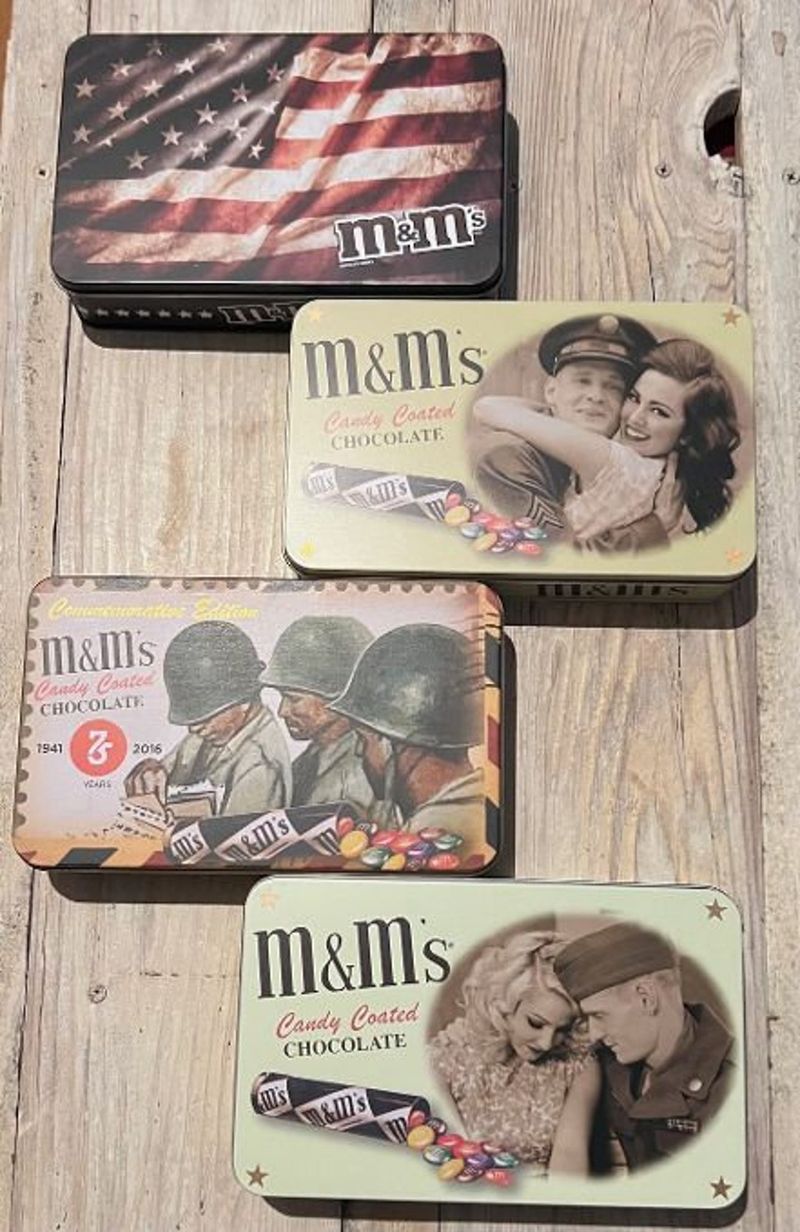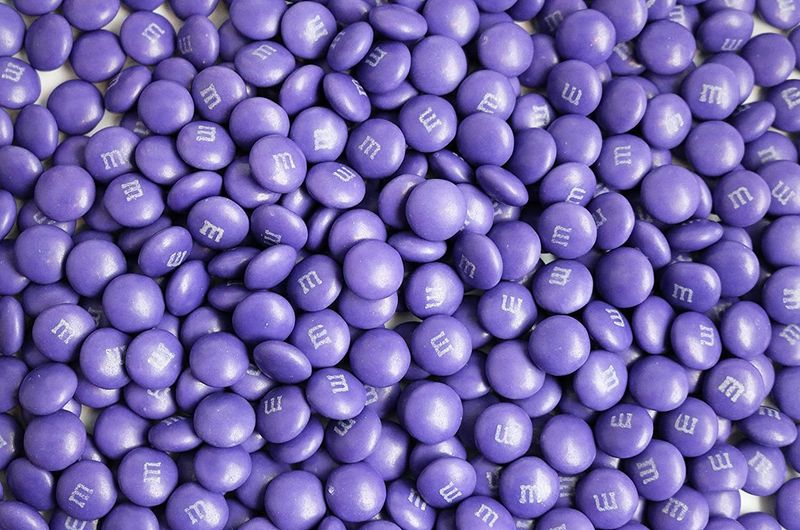M&M’s are more than just a tasty, colorful candy—they have a rich history, unexpected origins, and some truly surprising facts. From their creation as a wartime snack to their journey into space, M&M’s have become a cultural icon enjoyed by millions worldwide. Over the years, they’ve undergone color changes, inspired myths, and even had a role in presidential traditions. Whether you’re a casual fan or a true candy connoisseur, these 30 fun and surprising facts will make you see M&M’s in a whole new light. Get ready to dive into the sweet, fascinating world of one of America’s favorite treats!
1. Wartime Inspiration (1941)

M&M’s were born in 1941, thanks to Forrest E. Mars Sr.’s sweet stroke of genius. Inspired by soldiers during the Spanish Civil War munching on chocolate coated in sugar (so it wouldn’t melt), he saw an opportunity. Why not create a heat-resistant chocolate candy perfect for any climate? With that, M&M’s were born—tiny, colorful treats designed to stay solid in the heat and melt only in your mouth. Little did he know, his idea would become one of the most beloved candies in the world!
2. Name Origin: Mars & Murrie

Ever wondered what the M&M’s name really means? It’s not just catchy—it’s a candy power move! In 1940, Forrest Mars had big chocolate dreams but needed a steady supply. Enter Bruce Murrie, the son of a Hershey executive.
Mars struck a sweet deal, offering Murrie a 20% stake in exchange for access to Hershey’s chocolate. By combining their names, they created a lasting brand that would symbolize partnership and innovation. This clever naming also reflected a deep personal connection, intertwining their legacies in chocolate history.
3. WWII Rations

During World War II, M&M’s were exclusively made for U.S. soldiers, becoming a staple in their rations. This decision was driven by the candy’s durability and convenience, providing troops with a morale-boosting treat. The sugar shell ensured the chocolate remained intact, even in harsh conditions. This strategic move not only supported the war effort but also introduced M&M’s to a broader audience. The soldiers’ fondness for the candy helped propel its popularity post-war, solidifying its place in American culture and consumer markets.
4. First Packaging

After World War II, M&M’s became available to the general public, transitioning from a military ration to a widely sold confectionery. In 1948, the packaging changed from the original cardboard tubes to the brown paper bag, a design that, with modern updates, remains in use today.
This shift marked the beginning of M&M’s commercial success, establishing it as a popular everyday candy. The durable packaging helped ensure product freshness and convenience, contributing to M&M’s long-standing presence in the confectionery industry.
5. Famous Slogan (1949)

The famous slogan, “Melts in your mouth, not in your hand,” was introduced in 1949, capturing the unique quality of M&M’s. This catchy phrase emphasized the candy’s innovative design, where the hard shell protected the chocolate from melting. Such a simple statement resonated with consumers, highlighting a practical benefit that set M&M’s apart. The slogan became synonymous with the brand, echoing through generations as a testament to its quality and appeal. Its enduring popularity showcases the power of effective marketing in building a beloved and trusted brand identity.
6. The “M” Stamp (1950)

M&M’s were not originally stamped with their signature “M.” It wasn’t until 1950 that a black “m” was printed on each candy to distinguish them from imitators. In 1954, the black print was replaced with the now-iconic white “m.” To reinforce brand authenticity, advertisements encouraged consumers to “Look for the M on every piece.” This small but significant change helped M&M’s stand out in the growing confectionery market, ensuring customers were getting the original, high-quality product rather than lesser-known imitations.
7. Peanut M&M’s (1954)

Introduced in 1954, Peanut M&M’s were the first flavored variety of this beloved candy. Originally available only in tan, they offered a delightful twist on the classic chocolate treat. This innovation catered to consumers seeking more than just a chocolate fix, adding a nutty crunch to the experience.
The introduction of Peanut M&M’s marked the beginning of flavor diversification, paving the way for future variations. It showcased the brand’s commitment to innovation and consumer satisfaction, providing a new dimension to the candy that fans adored and celebrated.
8. Color Changes

The color palette of M&M’s has undergone fascinating changes, with violet originally part of the mix. In 1949, tan replaced violet, altering the candy’s visual identity. These changes reflected evolving consumer preferences and marketing strategies, keeping the candy fresh and exciting.
The choice of colors is more than aesthetic; it ties to the brand’s personality and appeal. Each hue is carefully selected to attract and delight, ensuring M&M’s remain visually captivating. This attention to detail highlights the brand’s adaptability and understanding of consumer desires.
9. Red Dye Scare (1976-1987)

From 1976 to 1987, red M&M’s were banned due to fears over the safety of red food dyes. Although M&M’s did not use the dye in question, consumer concerns led to their removal. This decision demonstrated the company’s commitment to consumer safety and responsiveness to public sentiment.
The absence of red M&M’s sparked curiosity and debate, highlighting the power of consumer perception. When they returned, it was with renewed confidence and a clear message about the brand’s dedication to quality and transparency.
10. Candy-Coated Technology

The candy-coated technology behind M&M’s involves a process known as hard panning. This method forms a sugar shell around the chocolate, creating the iconic candy we know today. The technique requires precision and expertise, ensuring each piece is perfectly coated. This innovation allows the chocolate to endure various conditions without melting, providing a consistent and enjoyable experience. The technology reflects both craftsmanship and scientific advancement, demonstrating how innovation in candy-making can lead to timeless products that delight generations.
11. Bite-Sized Stats

A single plain M&M weighs just 0.91 grams and contains 4.7 calories, making it a tiny yet satisfying treat. These bite-sized stats highlight the candy’s appeal as a guilt-free indulgence. The small size allows for portion control, catering to those mindful of their calorie intake.
Despite their minimal weight, M&M’s pack a flavorful punch, delivering a burst of chocolatey goodness in every bite. This efficiency in size and taste has been a key factor in their enduring popularity, appealing to both the health-conscious and the indulgent alike.
12. Mass Production (1950s)

Mars rapidly expanded M&M’s production to keep up with growing demand. By the early 1950s, the company, working with a research institute, developed an advanced method to coat approximately 3,300 pounds of chocolate centers per hour with the signature candy shell. This breakthrough significantly boosted efficiency, allowing M&M’s to transition from a wartime ration to a mainstream consumer favorite. As demand surged post-World War II, this innovation ensured a steady supply, helping M&M’s secure a dominant place in the confectionery market and paving the way for its continued success worldwide.
13. Global Reach

M&M’s have grown into a global brand, now sold in over 100 countries and produced in multiple Mars factories worldwide. By the 1980s, their popularity had expanded beyond the United States into markets across Europe, Australia, Asia, and beyond. This international growth solidified M&M’s as a universally recognized treat, enjoyed by millions across different cultures.
Their consistent quality, colorful appeal, and variety of flavors have helped them maintain a strong presence in the global confectionery industry for decades. This era marked a significant milestone in their history, reflecting the brand’s growth and ambition to satisfy chocolate lovers everywhere.
14. Flavor Variations

Over the years, Mars has introduced a variety of M&M’s flavors and fillings. In addition to the classic Milk Chocolate and the staple Peanut M&M’s, there have been regular flavors like Almond (first trialed in the 1960s, permanent by 1992), Peanut Butter (launched 1991 in the U.S.), Crispy (a crispy rice center, launched 1999), Pretzel (launched 2010), Caramel (2017), and even Dark Chocolate versions. Many other limited-edition flavors (mint, coffee, raspberry, etc.) have appeared over time to keep the brand fresh.
15. M&M’s Minis (1996)

In 1996, M&M’s Minis made their debut, offering a miniature version of the classic candy. Sold in convenient plastic tubes, these tiny treats quickly became a favorite for their portability and playful size. The introduction of Minis catered to on-the-go lifestyles, allowing fans to enjoy M&M’s in a new and exciting way.
Their small size made them perfect for snacking or sharing, adding a fun twist to the M&M’s experience. This innovation reflected the brand’s ability to evolve and adapt to changing consumer needs, bringing joy to candy lovers.
16. Mega M&M’s

Oversized Mega M&M’s were introduced in the 2000s, offering a larger-than-life version of the beloved candy. This bold innovation delighted fans seeking a more substantial chocolate experience. The increased size provided a satisfying crunch and more chocolate in every bite, appealing to those who craved a bigger indulgence.
Mega M&M’s showcased the brand’s willingness to push boundaries and explore new possibilities within their product line. This playful twist on the classic candy captured imaginations and taste buds, proving bigger can indeed be better.
17. E.T. Movie Snub (1982)

One of the most famous marketing decisions was when Mars said “no” to featuring M&M’s in Steven Spielberg’s 1982 film E.T. the Extra-Terrestrial. The film’s producers originally wanted Elliott to use a trail of M&M’s to lure the alien, but Mars declined. The opportunity went to Hershey’s Reese’s Pieces instead – and after E.T. became a blockbuster, Reese’s Pieces sales shot up by an estimated 65%, a boost M&M’s missed out on.
18. First Candy in Space (1981)

M&M’s hold the distinction of being the first candy to go to space. At the request of astronauts, they were included on NASA’s first space shuttle mission (Columbia) in 1981. Their durable candy shell made them ideal for zero-gravity snacking. M&M’s have since been a regular treat for astronauts (NASA refers to them generically as “candy-coated chocolates”), and special NASA-themed M&M’s were even made to commemorate the final shuttle flight in 2011.
19. 1995 Color Vote

In the mid-1990s, M&M’s marketing was reinvigorated by the introduction of the “spokescandies” – those colorful anthropomorphic M&M’s characters seen in commercials. The original cast (1995) featured Red, Yellow, Green, and Blue M&M characters, each with a unique personality.
They soon added Orange (the anxious crispy M&M) and Ms. Brown (the savvy brown M&M). These cartoon mascots, brought to life with CGI and humor, turned M&M’s into not just a candy but a cast of characters that fans love.
20. M&M’s Characters (1995)

In 1995, M&M’s ran a high-profile “Color Campaign” that let the public vote on a new color to add to the standard mix. Voters chose between purple, blue, or pink, and blue won – meaning the longtime tan M&M was retired.
The announcement of blue M&M’s made national news (even David Letterman and Jay Leno joked about it), and Mars celebrated by lighting the Empire State Building in blue. This campaign earned M&M’s a wave of free publicity and firmly cemented the new blue candy in the lineup.
21. 2002 Global Color Vote

M&M’s repeated the color election idea on a worldwide scale in 2002. This time it was a global vote to pick a new color from three options: purple, aqua, or pink. The response was huge – around 10 million votes were cast by fans around the world, and purple won the vote. Despite winning that contest, purple M&M’s were produced only in limited runs or specialty packs at the time, not as a permanent color in every bag.
22. Millennium Marketing (2000)

In the year 2000, M&M’s declared themselves “The Official Candy of the New Millennium,” creatively tying the Roman numeral MM for 2000 to their brand. This clever marketing move emphasized their timeless appeal and readiness to embrace the future. The campaign celebrated both the dawn of a new era and the candy’s enduring popularity. By associating with the millennium, M&M’s reinforced their position as a cultural icon, inviting consumers to celebrate the new age with a familiar treat. This strategic branding highlighted their adaptability and forward-thinking nature.
23. M&M’s World Stores (1997)

M&M’s World stores first opened in 1997, offering immersive experiences in locations like Las Vegas, NYC, and London. These themed retail spaces became destinations for candy lovers, providing interactive and engaging environments. The stores showcased the brand’s playful spirit, with vibrant displays and exclusive merchandise.
This expansion into retail demonstrated M&M’s commitment to creating memorable experiences for fans, blending fun with shopping. The concept of M&M’s World reflected the brand’s innovation and desire to connect with consumers beyond traditional sales, offering a unique adventure in the world of candy.
24. Ms. Brown Debuts (2012)

Ms. Brown, the confident brown M&M character, debuted in 2012, voiced by the talented Vanessa Williams. Her introduction added sophistication and wit to the M&M’s lineup of animated mascots. Ms. Brown’s character brought a new depth to the brand, showcasing intelligence and elegance. Her presence resonated with fans, enhancing the emotional connection with the candy. This addition reflected M&M’s commitment to diversity and representation within their brand narrative, offering a fresh perspective that enriched their storytelling and engaged a broader audience with her charm and character.
25. Holiday Ad (1996)

The classic holiday ad from 1996 featuring Red and Yellow M&M’s fainting upon seeing Santa Claus has become a beloved tradition. This humorous and heartwarming commercial captures the magic and whimsy of the holiday season. The ad’s enduring popularity showcases the power of storytelling in building brand identity and emotional connections. It reflects M&M’s ability to blend humor with sentimentality, creating memorable moments that resonate with audiences year after year. This timeless commercial has become an integral part of holiday celebrations, symbolizing joy and laughter.
26. Cultural Icons

M&M’s have become cultural icons, appearing in the Macy’s Parade, movies, and video games. Their presence in various media highlights their widespread appeal and impact on popular culture. These appearances showcase the brand’s versatility and ability to engage with diverse audiences.
M&M’s cultural influence reflects their role as more than just a candy but as a beloved symbol of fun and joy. Their integration into different aspects of entertainment underscores the brand’s adaptability and enduring popularity, cementing their status as a cherished part of cultural narratives.
27. No Brown M&M’s Clause

The infamous “No Brown M&M’s” clause in Van Halen’s contracts was a test to ensure attention to detail by venues. This unusual request became legendary, symbolizing the band’s meticulous standards. While seemingly trivial, it served a practical purpose, revealing whether contract terms were thoroughly followed.
The clause highlights the power of branding and the influence of pop culture preferences. M&M’s inclusion in such a unique demand underscores their iconic status and ability to capture public imagination. The story illustrates how even small details can have significant impact.
28. Green M&M Myth

In the 1970s, a playful rumor claimed that green M&M’s had aphrodisiac properties, sparking curiosity and intrigue. Although rooted in myth, this tale added to the candy’s mystique and allure. The story reflects the fun and whimsical nature of M&M’s, capturing imaginations with its playful narrative. While the myth holds no scientific basis, it highlights how urban legends can enhance a brand’s intrigue. M&M’s embraced the curiosity, allowing the myth to become part of their colorful history, showing how even myths can create lasting brand engagement.
29. Presidential M&M’s

Since 1988, U.S. presidents have handed out official M&M’s adorned with the presidential seal as a symbol of American hospitality and tradition. These special candies, often given to guests and dignitaries, reflect the candy’s prestigious status and national pride. The tradition underscores M&M’s role as a cultural ambassador, representing the sweet side of American diplomacy. This unique honor highlights the candy’s integration into national customs and its ability to convey goodwill and charm. The presidential M&M’s tradition is a testament to the candy’s iconic status and timeless appeal.
30. Personalized M&M’s (2004)

In 2004, Mars launched My M&M’s, allowing customers to print custom messages and images on the candies. This innovation offered a new level of personalization, catering to special occasions and unique expressions. The ability to create bespoke M&M’s added a personal touch, making them perfect for gifts and celebrations. This creative endeavor reflected the brand’s commitment to consumer engagement and individuality, enhancing the emotional connection with fans. By offering personalized candies, M&M’s demonstrated their adaptability and desire to make meaningful moments even sweeter.
Leave a comment